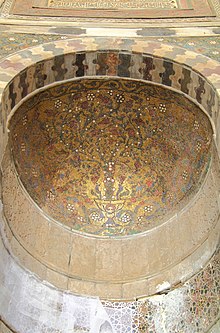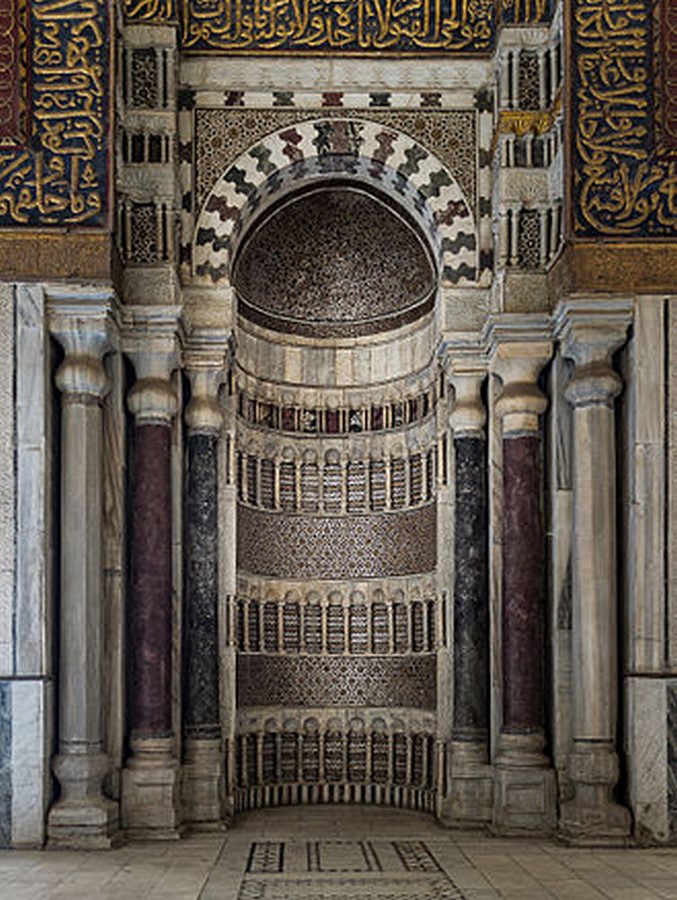Qalawun Complex: A Cairo Marvel

Welcome to the marvel that is the Qalawun Complex in Cairo! This historic architectural gem holds great significance and is a must-visit destination for history and architecture enthusiasts alike. Let's delve into the rich history and stunning architecture of the Qalawun Complex.
The Significance of the Qalawun Complex in Cairo
The Qalawun Complex, named after its founder, Sultan al-Mansur Qalawun, is a testament to the grandeur and power of the Mamluk dynasty in Egypt. Built in the 13th century, the complex was a necropolis, madrasa (Islamic school), and a hospital. Its multifunctional nature reflects the comprehensive approach of the Mamluks in serving their community.
This complex holds great historical significance, as it was constructed when the Mamluks were exerting their dominance in the region. It stands as a symbol of their architectural prowess and their commitment to education and healthcare.
Overview of the Qalawun Complex Architecture
The Qalawun Complex boasts a stunning blend of architectural styles, combining elements of Islamic, Mamluk, and Ottoman design. The complex is characterized by its intricate details, majestic domes, and soaring minarets.
At the heart of the complex is the mausoleum of Sultan Qalawun, which features beautifully carved marble and ornate decorations. It is a testament to the artistic skills and craftsmanship of the time.
Adjacent to the mausoleum is the striking Qalawun Mosque, known for its impressive minarets and spacious prayer halls. The mosque showcases intricate geometric patterns and delicate calligraphy, adding to its beauty and splendour.
The complex also includes a madrasa, which served as an educational institution for Islamic studies. The madrasa's architectural elements, such as its courtyard and lecture halls, are designed to facilitate a conducive learning environment.
Additionally, the Qalawun Complex features a hospital, a pioneering institution in its time. It provided free healthcare to those in need, emphasizing the Mamluk's commitment to the welfare of their subjects.
Visiting the Qalawun Complex allows you to step back in time and appreciate the architectural and historical significance of this marvel. It is a testament to the vibrant history and cultural heritage of Cairo and Egypt.

History of the Qalawun Complex
The Origin and Purpose of the Qalawun Complex
Welcome to the magnificent Qalawun Complex in Cairo! This architectural masterpiece holds great historical significance and offers a glimpse into the grandeur of the Mamluk dynasty. Built-in the 13th century by Sultan al-Mansur Qalawun, the complex served multiple purposes, making it a unique and multifaceted structure.
The Qalawun Complex was designed as a necropolis, a final resting place for Sultan Qalawun and his family. It also housed a madrasa, an Islamic school where students could receive a comprehensive education in various fields of study. In addition, the complex featured a hospital, a groundbreaking institution providing free healthcare to those in need.
Construction Process and Notable Architects Involved
The construction of the Qalawun Complex was a remarkable feat of architectural prowess. The complex showcases a harmonious blend of Islamic, Mamluk, and Ottoman design elements, demonstrating the influence of different cultures during that era.
Notable architects and craftsmen of the time were involved in bringing Qalawun's vision to life. Their attention to detail and mastery of intricate craftsmanship can be seen throughout the complex. From the beautifully carved marble in the mausoleum to the delicate calligraphy and geometric patterns adorning the Qalawun Mosque, every aspect of the complex was meticulously constructed.
The striking minarets and spacious prayer halls of the mosque are a testament to the architectural genius of the Mamluks. They created a space that is not only awe-inspiring but also conducive to spiritual reflection and prayer.
Including a madrasa within the complex demonstrates the Mamluk's commitment to education. The meticulously designed courtyard and lecture halls provided a stimulating environment for students to immerse themselves in Islamic studies and gain a comprehensive education.
The Qalawun Complex is a testament to the Mamluks' dedication to serving their community. Their commitment to the welfare of their subjects is evident in the inclusion of a hospital within the complex. This pioneering institution offered free healthcare, a concept ahead of its time and a shining example of its benevolence.
Visiting the Qalawun Complex is a journey through history and a chance to appreciate the architectural and cultural heritage of Cairo. It serves as a reminder of the power, grandeur, and benevolence of the Mamluk dynasty, leaving visitors in awe of its beauty and historical significance.
Qalawun Complex Architecture
The Qalawun Complex in Cairo is a true marvel of architectural brilliance. As you explore this magnificent structure, you will be captivated by its rich history and intricate design elements. Let's delve into the architectural features of two prominent components of the complex: the Qalawun Mosque and the Mausoleum of Qalawun and his family.
Qalawun Mosque: Design and Structural Elements
The Qalawun Mosque, located within the complex, is a testament to the architectural genius of the Mamluks. Its design reflects a harmonious blend of various influences, showcasing Islamic, Mamluk, and Ottoman elements. As you step inside, you will be greeted by the beauty and serenity of the prayer hall.
The mosque's structural elements are awe-inspiring. The grand minarets rise majestically, reaching the heavens, symbolizing the connection between the earthly and the divine. The spacious prayer hall allows natural light to filter in, creating a serene atmosphere for prayer and reflection. The intricate geometric patterns and delicate calligraphy adorning the walls and ceilings serve as a visual feast for the eyes, showcasing the mastery of craftsmanship during that era.
Mausoleum of Qalawun and Family: Artistic Features and Tombs
The Mausoleum of Qalawun and his family, another integral part of the complex, is a masterpiece of artistic expression. Inside the mausoleum, you will find beautifully carved marble that adds a touch of elegance to the space. These artistic features enhance the overall solemnity of the area, paying homage to the Sultan and his family.
The mausoleum is the final resting place of Sultan Qalawun and his loved ones. The tombs, intricately adorned with intricate calligraphy and delicate stone carvings, provide a glimpse into the opulence of the Mamluk dynasty. As you explore this sacred space, you will feel a sense of reverence and admiration for the remarkable craftsmanship that went into creating these tombs.
Visiting the Qalawun Complex allows you to witness the architectural and cultural heritage of Cairo firsthand. From the majestic Qalawun Mosque to the artistic marvels of the mausoleum, every aspect of the complex tells a story of the Mamluk dynasty's power, grandeur, and commitment to their culture. Please take a moment to appreciate the beauty and historical significance of this Cairo marvel, and let it inspire you as you contemplate the wonders of human creativity across the ages.

Qalawun Complex Decorations
When you visit the Qalawun Complex in Cairo, you will be mesmerized by the intricate and stunning decorations that adorn both the interior and exterior of the complex. These decorations are a testament to the artistic brilliance of the Mamluk dynasty and serve as a reflection of their rich culture and history. Let's explore the intricate details of the decorations and understand the significance of the calligraphy and geometric patterns used in this architectural marvel.
Intricate details of the interior and exterior decorations
As you explore the Qalawun Complex, you will notice that every nook and corner is adorned with exquisite decorations. The complex's interior is adorned with delicate stone carvings, beautifully carved marble, and ornate woodwork. These meticulously crafted details create a sense of grandeur and elegance that is truly awe-inspiring. The exterior of the complex features intricate geometric patterns, intricate carvings, and exquisite tilework that enhance the visual appeal of the complex.
The attention to detail in the decorations is truly remarkable. The craftsmen of the Mamluk dynasty were masters of their art, and their skills are evident in the intricate designs that cover the walls, ceilings, and arches of the complex. Each decoration serves a purpose, whether it is to evoke a sense of awe and reverence or to create a harmonious and visually pleasing environment.
Significance of calligraphy and geometric patterns
Calligraphy and geometric patterns play a significant role in the decorations of the Qalawun Complex. Calligraphy, in particular, holds a special place in Islamic art and is considered a form of artistic expression. The Arabic calligraphy used in the complex is not merely decorative but also holds religious and symbolic meanings. The verses from the Quran and religious phrases that adorn the walls and ceilings serve as a reminder of the spiritual significance of the complex.
Geometric patterns, on the other hand, are a common feature in Islamic art and architecture. These patterns symbolize the harmony and unity of the universe and are believed to represent the divine order. The intricate geometric patterns used in the Qalawun Complex create a sense of harmony and balance that is both visually pleasing and spiritually uplifting.
The decorations in the Qalawun Complex are not just ornamental; they are a testament to the rich history, culture, and artistic genius of the Mamluk dynasty. It is a marvel that showcases the brilliance of craftsmanship and the artistic expression of a bygone era. As you explore this magnificent complex, take a moment to appreciate the intricate details and let the beauty of the decorations transport you to a time of grandeur and elegance.

Qalawun Complex Restoration
Efforts and challenges in preserving the Qalawun Complex
When you visit the Qalawun Complex in Cairo, you will witness the enduring beauty and historical significance of this architectural marvel. However, preserving and restoring such a complex is not without its challenges. Efforts have been made to ensure the long-term preservation of this cultural gem, but it has not been an easy task.
Over time, the Qalawun Complex has faced numerous challenges, including natural deterioration, environmental factors, and even human intervention. The delicate stone carvings, ornate woodwork, and exquisite tilework require constant care and attention to maintain their original splendour.
To overcome these challenges, restoration efforts have been undertaken to preserve the complex's unique features. Skilled craftsmen and preservation experts have carefully documented, repaired, and cleaned the intricate decorations. This meticulous approach aims to restore the complex to its original glory while ensuring its authenticity.
However, the restoration process is not without its difficulties. The complex's sheer size and intricate details make the restoration a time-consuming and resource-intensive endeavour. It requires a skilled team of conservationists, architects, and craftsmen who understand the historical context and have a deep appreciation for the craftsmanship of the Mamluk dynasty.
The current state of the complex and future plans
Despite the challenges, significant progress has been made in restoring the Qalawun Complex. Thanks to the tireless efforts of the restoration teams, visitors can now experience the complex's grandeur and appreciate the rich cultural heritage it represents.
The interior and exterior decorations have been meticulously restored, allowing visitors to admire the delicate stone carvings, beautifully carved marble, and ornate woodwork. The intricate details, once hidden beneath layers of dust and decay, now shine brightly, showcasing the artistic brilliance of the Mamluk dynasty.
Looking ahead, there are plans to improve further the preservation and visitor experience at the Qalawun Complex. These plans include implementing advanced conservation techniques, increased accessibility for tourists, and educational programs to promote the understanding and appreciation of the complex's historical significance.
Preserving the Qalawun Complex is not only essential for maintaining Egypt's rich cultural heritage but also for ensuring that future generations can continue to appreciate its beauty and historical value. The ongoing restoration efforts serve as a reminder of the importance of safeguarding cultural treasures and the tireless dedication required to preserve them.
So, when you step into the Qalawun Complex, take a moment to admire the intricate details and appreciate the remarkable efforts that have gone into preserving this Cairo marvel. It is a testament to the enduring human spirit and our collective commitment to safeguarding our shared history.

Restoring the Qalawun Complex: Preserving Cairo's Cultural Marvel
The Qalawun Complex in Cairo stands as a magnificent architectural marvel, showcasing the rich cultural heritage of the Mamluk dynasty. Despite the challenges in preserving and restoring the complex, significant progress has been made. The efforts of skilled craftsmen and restoration teams have allowed visitors to experience the grandeur and historical significance of this cultural gem.
The restoration process has involved meticulous documentation, repair, and cleaning of the complex's intricate decorations, ensuring the authenticity and original splendour are maintained. The delicate stone carvings, ornate woodwork, and exquisite tilework now shine brightly, captivating visitors with their artistic brilliance.
Looking ahead, there are plans to improve further the preservation and visitor experience at the Qalawun Complex. Advanced conservation techniques will be implemented, aiming to protect the complex from natural deterioration and environmental factors. Additionally, increased accessibility for tourists and educational programs will promote a deeper understanding and appreciation of the complex's historical significance.
Preserving the Qalawun Complex is not only a testament to Egypt's rich cultural heritage but also a commitment to safeguarding our shared history. The ongoing restoration efforts serve as a reminder of the enduring human spirit and the importance of preserving cultural treasures for future generations.
So, when you visit the Qalawun Complex, take the time to admire the intricate details and appreciate the remarkable efforts that have gone into preserving this Cairo marvel. It is an opportunity to immerse
